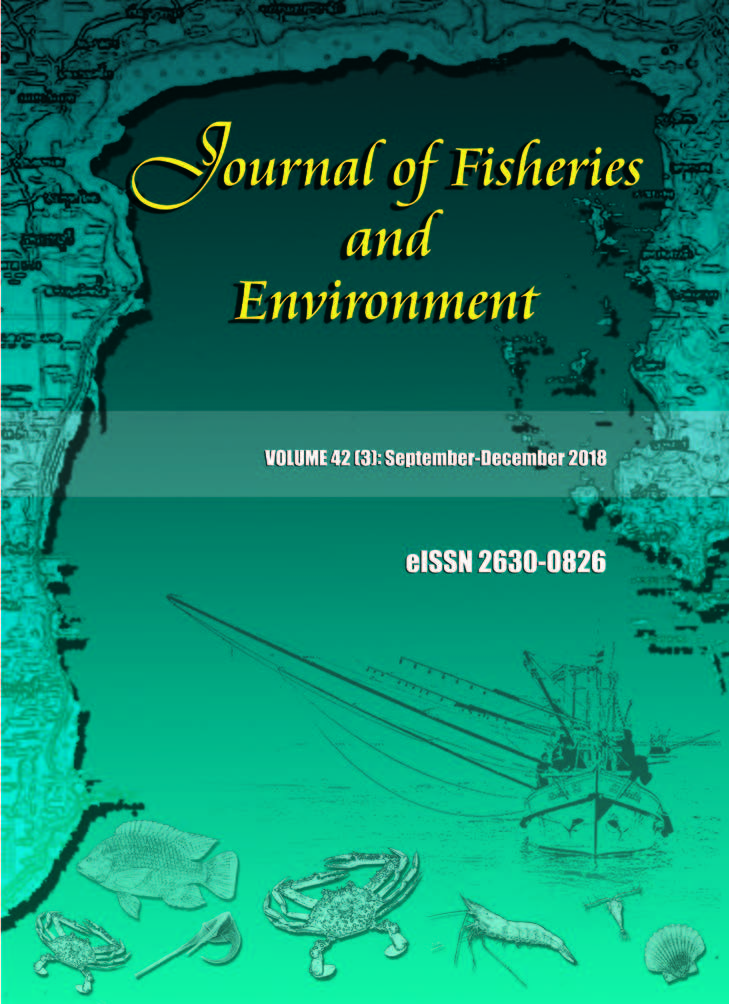Changes of Chlorophyll a in an Intertidal Bangtaboon Estuary in Relation to Tidal Driven Salinity and Nutrients
Main Article Content
Abstract
This study analyzes the impacts of tidal-driven salinity and orthophosphate on chlorophyll a in a tropical intertidal Bangtaboon estuary, along the western Gulf of Thailand. Field surveys were carried out at 12 stations during low-, medium-, and high-loading periods in May, July, and November 2015. Results indicated that chlorophyll a varied by season. Particularly during high loading periods when orthophosphate increased, chlorophyll a levels were higher. In general, the levels of chlorophyll a here reflected hypertrophic condition of the ecosystem. The median concentration of chlorophyll a can be recognized ca. 2-3 hours after the highest tidal amplitude. In addition, the water masses with 24 psu salinity experienced the greatest chlorophyll a production. The role of salinity in chlorophyll a production was found to be enhanced by amplitudes and pulses of the tidal patterns. To support environmental conservation and maintain sustainable production in the estuary, orthophosphate concentrations along the highly productive water mass should be carefully monitored and further controlled by suitable management approaches.
Article Details
References
2. Azhikodan, G. and K. Yokoyama. 2016. Spatio-temporal variability of phytoplankton (chlorophyll-a) in relation to salinity, suspended sediment concentration, and light intensity in a macrotidal estuary. Continental Shelf Research 126: 15-26.
3. Buakaew, K., C. Meksumpum and S. Meksumpun. 2016. Influence of tidal changes on primary production and aquatic environmental factors in the Bang-Tabun estuary Phetchaburi Province. Proceedings of the 5th Research Conference of Phayoa University (Phayoa, Thailand). pp. 446-455.
4. Bucci, A.F., A.M. Ciotti, C.G. Pollery, R. RCarvalho, H.C. Albuquerque and L.T.P. Simoes. 2012. Temporal variability of chlorophyll-a in the Sao Vicente estuary. Brazil. Journal of Oceanography 60 (4): 485-499.
5. Bukaveckas, P.A., E.L. Barry, M.J. Beckwith, V. David and B. Lederer. 2011.
Factors determining the location of the chlorophyll maximum and the fate of algal production within the tidal freshwater James River. Estuaries and Coasts 34: 569-582.
6. Department of Fisheries. 2014. Fisheries statistics of Thailand 2010-2014. Department of Fisheries. Thailand. 93 pp.
7. Duarte, C.M. 2009. Coastal eutrophication research: A new awareness. Hydrobiology 629 (1): 263-269.
8. Fisher, R.T., W.L. Harding Jr, W.D. Stanleyand and G.L. Warda. 1988. Phytoplankton, nutrients, and turbidity in the Chesapeake, Delaware, and Hudson estuaries. Estuarine, Coastal and Shelf Science 27(1): 61-93.
9. Huang, L., W. Jian, X. Song, X. Huanga, S. Liu, P. Qian, K. Yin and M. Wu. 2004. Species diversity and distribution for phytoplankton of the Pearl River estuary during rainy and dry seasons. Marine Pollution Bulletin 49(7–8): 588-596.
10. Hydrographic Department. 2016. Tide tables Thai waters. Mae Nam Chaophraya – Gulf of Thailand and Andaman Sea. Royal Thai Navy, Thailand.
11. Lallu, K.R., K.H. Fausia, J. Vinita, K.K. Balachandran, K.R.N. Kumar and T.V. Rehitha. 2014. Transport of dissolved nutrients and chlorophyll a in a tropical estuary, southwest coast of India. Environmental Monitoring and Assessment 186: 4829-4839.
12. Liu, H., L. Huang, X. Song and Y. Zhong. 2011. Using primary productivity as index of coastal eutrophication: A case study in Daya Bay. Water and Environment Journal 26: 235-240.
13. Mao, X., C. Kuang, J. Gu, O. Kolditz, K. Chen, J. Zhang, W. Zhang and Y. Zhang. 2017. Analysis of chlorophyll-a correlation to determine nutrient limitations in the coastal waters of the Bohai Sea, China. Journal of Coastal Research 33(2): 396-407.
14. Meksumpun, C., S. Ajjimangkul, S. Meksumpun, U. Netharn and J. Srisomwong, 2012. Integration on eco-hydrology, population biology, and community knowhow for development of blood clam effective culture: A case study of Bang-Tabun Bay, Phetchaburi province. Proceeding of the 7th Academic Conference of Maejo University (Chiangmai, Thailand). pp. 46-47.
15. Menéndez, M.C., A.L. Delgado, A.A. Berasategui, M.C. Piccolo and M.S. Hoffmeyer. 2016. Seasonal and tidal dynamics of water temperature, salinity, chlorophyll-a, suspended particulate matter, particulate organic matter, and zooplankton abundance in a shallow, mixed estuary (Bahía Blanca, Argentina). Journal of Coastal Research 32(5): 1051-1061.
16. Montani, S., P. Magn, M. Shinamoto, N. Abe and K. Okutani. 1998. The effect of tidal cycle on the dynamic of nutrients in a tidal estuary in the Seto Inland Sea, Japan. Journal of Oceanography 54: 65-76.
17. Otsuka, A.Y., Feitosa, F.A.N.; Flores-Montes, M.J., and Silva A. 2016. Dynamics of chlorophyll a and oceanographic parameters in the coastal zone: Barra das Jangadas-Pernambuco, Brazil. Journal of Coastal Research 32(3): 490-499.
18. Paches, M., I. Romero, R. Martinez-Guijarro, C.M. Marti and J. Ferrer. 2014. Changes in phytoplankton composition in a mediterranean coastal lagoon in the Cullera estuary (Comunitat Valenciana, Spain). Water and Environment Journal 28: 135-144.
19. Parsons T.R, Y. Maita and C.M. Lalli. 1984. A Manual of Chemical and Biochemical Methods for Seawater Analysis. Pergamon Press, New York. 173 p.
20. Pauly, D. and V. Christensen. 1995. Primary production required to sustain global fisheries. Nature Journal 374: 255-257.
21. Sangmek, P. and C. Meksumpun. 2014. Assessment of impacts from various hydro-ecological factors on oxygen budgets of a regulated river: A case study of the Phetchaburi River, western Thailand. Water Science and Technology 69 (7): 1565-1572.
22. Sangmek, P. and C. Meksumpun. 2015. Influence of eco-hydrological factors on aquatic plant succession in a regulated river: A Case Study of the Petchburi River, Thailand. Water and Environment Journal 29 (2): 243-251.
23. Thai Meteorological Department (TMD). 2014. Climate of Thailand. Thai Meteorological Department, Thailand. https://www.tmd.go.th/en/archive/season.php. Cited 25 May 2016


